| |
|
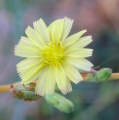 | |
| MaltaWildPlants.com by Stephen Mifsud |

|
| |
|
|
 |  |  |  |
| External Links: |
|
Muscari parviflorum (Autumn Grape Hyacinth) |
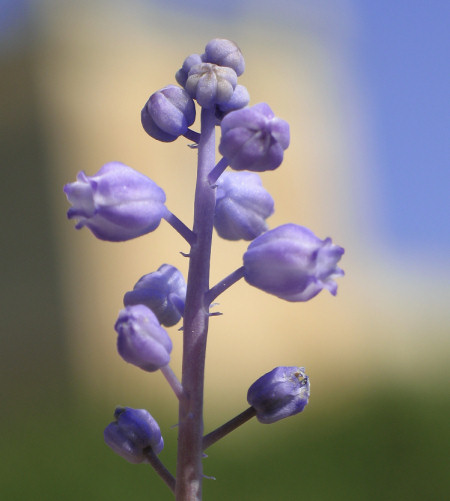
Muscari parviflorum (ASPARAGACEAE.)
Images for this profile are taken from the Maltese Islands after year 2000. |
|
| Nomenclature |
Species name : | Muscari parviflorum Desf. | Authority : | Rene Louiche Desfontaines, France, (1750 - 1833) | Synonyms :
(basionym or principal syn.) |
|
Plant Family : | Asparagaceae Juss. (= Liliaceae )
(Asparagus Family) | English name(s) : | Autumn Grape Hyacinth, Lesser Grape Hyacinth, Small-flowered Hyacinth | Maltese name(s) : | Ġjaċint tal-ħarifa | Status for Malta : | Indigenous. Present on the Maltese islands before man | Name Derivation : |
Muscari: Greek word for musk - a greasy secretion with a strong fragrant odour, produced in a glandular sac beneath the skin of the abdomen of the male musk deer and used in the manufacture of perfumes. Flowers of many species of this genus have this scent. (Greek origin ); 2 = Musk (Greek); Musk is a greasy secretion with a powerful odour, produced in a glandular sac beneath the skin of the abdomen of the male musk deer and used in the manufacture of perfumes.
parviflorum: small flowers, usually in comparison to flowers of other species in the same genus. (Greek origin ); 2 = from the Greek "parvus" = small, and "flora" = flower, hence small-flowered. (Greek).
| Remarks : | |
|
| Morphology and structure |
PLANT STRUCTURE: |
Character | Growth Form | Branching | Surface |
Description | | | |
General
Picture |  | 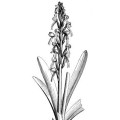 | 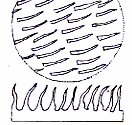 |
|
LEAVES: |
Character | Arrangement | Attachment | Venation |
Description | | | |
General
Picture | 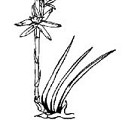 | 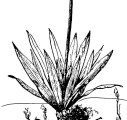 |  |
| |
Character | Leaf Shape | Leaf Margin | Remarks |
Description | | | Leaf Cross Section Channeled (U-shaped) due to the up-curved leaf margins. |
General
Picture |  |  |  |
|
FLOWERS: |
Character | Colour | Basic Flower Type | No. of Petals | No. of Sepals |
Description | Pale Violet Corolla tube is pale violet with 6 darker longitudinal vein. | | 6 To be botanically precise, the flower has 3 sepals (outer whorl) and 3 petals (inner whorl) which are identical, and so they are collectively referred to as 6 tepals or perianth segments. | 0 |
General
Picture | |  |  |  |
| |
Character | Inflorescence | Description | Ovary | Stamens |
Description | | Urn-shaped flowers attached to the scape by a short pedicel. The corolla tube is made up of 6 fused tepals and has a small opening with 6 tiny teeth at its outer end. 6 dark violet veins are found running longitudinally along the pale blue-violet corolla tube and each meet one of the teeth at the rim. | | |
General
Picture |  |  | 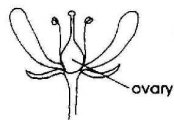 | 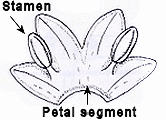 |
| |
Character | Scent | Average Flower Size | Pollen Colour | Other Notes |
Description | YES Faint fragrance which can be missed in windy days or late afternoon. | 5mm x 4mm Length x widest diameter of the corolla. | Bright Yellow | - |
|
SEEDS: |
Character | No. Per Fruit | Shape | Size | Colour |
Description | 3 (1 per locule, 3 locules per fruit.). | Ovoid Seeds have a lemon-like oval shape. | 2mm long | Black (with a slightly shiny surface). |
General
Picture |  |  |  |  |
|
FRUIT AND OTHER BOTANICAL DATA: |
Character | Fruit Type | Colour of Fruit | Subterranean Parts | Other Notes |
Description | | Green Turns beige when ripe and dry. | | - |
General
Picture | 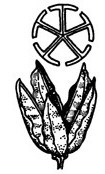 |  |  |  |
|
|
| Plant description and characters | |
Life Cycle: | Perennial. |
Growth Form: | GEOPHYTE (bearing underground bulbs, rhizomes, stolons, etc.) |
Habitat: | Steppe, abandoned field and exposed garigue with moderately deep soil. |
Frequency: | Scarce |
Localities in Malta: | Ta' Xbiex close to shore facing Argotti, Wardija Ridge, Wied il-Ghasel. |
Plant Height: | 25cm. |
| Sep-Oct |
Protection in Malta: | Not legally protected till the last update of this website (2/Mar/2022) |
Red List 1989: | Not listed in the Red Data Book of the Maltese Islands |
Poison: | |
A hyacinth that is often found in populations on thick soil patches on garigue and steppe. It is one of the first plants in Malta to flower after the first showers in September.
The plant has an ovoid bulb, about 2cm long, with a brown tunic. Each bulb forms 2 - 6 leaves (usually 4) which grows erect and close to each other. They have a vivid green colour, linear shape, glabrous and a channeled cross section. The edges of the lamina tip are bent inwards and overlap each other. Parallel venation is more prominent at the back side of the leaf (the convex part) while a pale midrib is sometimes noticed on the other side. Length of leaves vary from few to 15 cm, while the width is fixed between 2-3mm. They are shorter from the flowering scape.
The plant forms a single scape (flowering stalk) holding around 12 flowers. The lowest flower is the one to blossom first, and blossoming progress gradually up the scape. Mature flowers have a developed pedicel of about 3-4mm long while the un-mature flowers above, have shorter pedicels with the uppermost ones seem to be sessile.
Unlike the other few Muscari species in Malta, the flowers of the Autumn Grape Hyacinth are almost all fertile. The corolla is made up of 6 fused tepals to form an inflated tube shape structure which is pale violet-blue. The terminal opening of the corolla is relatively wide (3mm diameter) and is decorated by 6 tiny, acute teeth - bent slightly outwards. The corolla is further decorated by 6 longitudinal, equidistant, dark violet veins running along the corolla and meet the teeth at the corolla rim.
The reproductive organs consist of 6 stamens and a central ovary. The stamens are attached to the corolla wall (at the locus of the veins) and are divided into 2 rows (about 1-2mm apart). They have very dark anthers which produce pollen with bright yellow colour. They do not protrude out from the corolla mouth. The sub-globose ovary is pale blue with a short and stout white style and an inconspicuous terminal stigma.
The fertilised ovary develops to a bead-sized fruit which is ovoid in shape. Mature fruit has a cross section with three obtuse angles, typical of several lily fruits. The fruit capsule splits open into 3 longitudinal parts and liberate the small black seeds.
|
|
| Information, uses and other details |
Nativity and distribution
The distributional range of this plant is shown in the list below: [WWW-26]
Northern Africa: Algeria (n.); Egypt (n.); Libya (n.); Tunisia
Europe: Cyprus, Turkey (w.), Greece, Italy, Yugoslavia, Spain
This species of Muscari can be found in the Mediterranean area, from Spain to Turkey and south up to Tunisia. [WWW-159]
Notes on the Genus Muscari
The genus Muscari is called commonly grape-hyacinth (from Greek "moschos",
musk, alluding to the scent of the flowers). It contains perennial, scapose herbs with
ovoid bulbs, with or without bulblets; cataphylls from greyish to brown. Leaves (1-) 2-7,
basal; blade linear, sometimes sulcate, glabrous, rather fleshy. Scape terete.
Inflorescences terminally racemose, many-flowered,
dense, bracteate, usually elongating in fruit; distal flowers smaller, sterile, differing
in color, forming a tuft; bracts minute. Flowers fragrant; perianth tubular to
urceolate, usually constricted basally; tepals 6, connate most of their length, distal
portions distinct, reflexed, short, tooth-like; stamens 6, epitepalous, in 2 rows,
included; anthers dark blue, dorsifixed, globose; ovary superior, green, 3-locular,
inner tepals with nectaries; style 1; stigma 3-lobed. Fruits capsular, obtusely 3-
angled, papery, dehiscence loculicidal. Seeds 6, black, globose, wrinkled to
reticulate. x = 9. [378]
This genus has a widespread distribution. It is present in the whole Mediterranean
basin as far as Caucasus; temperate Europe, north Africa, southwest Asia. It is
expected introduced elsewhere and likewise contain a number of ornamentals [378]
A shorter description of Muscari by another reference [WWW-166] is as follows:
Bulbous perennials. Leaves all basal, linear, flat or grooved, more or less fleshy. Flowers small, flask-shaped, oblong to globose, constricted at mouth, crowded in stiff, erect racemes, apical flowers often smaller and sterile; lobes very short, tooth-like, often reflexed; pedicels short; bracts minute or 0. Capsule loculicidal, triquetrous. Seeds ± globose, few, glossy, black, often wrinkled.
Personal Observations
Flowering Time
In Malta, it is the only Muscari species that flowers in Autumn just after the first showers in September [SM]. According to some references such as [WWW-159], this is also true for other countries. For this reason it is referred to as the Autumn Grape Hyacinth and previously had the botanical name Muscari autumnalis (autumnalis = referring to its autumn flowering habit)
Not much information has been found about this particular plant species. If you can supply further info to be included in this profile, please do not hesitate to email us pr by using the form found at the botom of this page. Full reference credits will be given accordingly. Thank you for your support!
|
|
| Links & Further literature
(0 papers) |

Google Web |

Google Images |

Google Scholar |

Research Gate |

Wikipedia |

JSTOR |

GBIF |

Med Checklist |

Cat. of Life |

EoL |

IPNI |

World Flora Online |

Plants of the World Online |

Vienna Virt. Herb. |

RBGE Herbarium |

KEW Herbarium |

MNHN |

Arkive |

IUCN |

CABI |
Kindly Email if there are papers and publications about local
studies or information about this species to be included in the list above.
|
| Photo Gallery (38 Images) |  |
 |
 |
 |
IMAGE: MUSPV-01 Photo of small population of plants with the capital city of Valletta at the background. |
IMAGE: MUSPV-02 Photo of plants having purple-violet flowers on long flowering stalks. In shade, the flowering stalks grow longer. |
IMAGE: MUSPV-03 Photo of several flowers in shade (giving a more bluish hue). There is usually about 12 flowers which are all or most of them fertile. On contrast, other Muscari species in Malta have a large proportion of their upper flowers that are sterile. |
IMAGE: MUSPV-04 Photo of flowering stalk with its urn-shaped flowers. The single flowering stalk that these monocot plants produce is sometimes referred to as a scape. |
 |
 |
 |
 |
IMAGE: MUSPV-05 Photo of inflorescence. |
IMAGE: MUSPV-06 Photo of two flowers (side view) showing their inflated-tube shape (or sometimes referred as urn-shape) of the corolla made of 6 fused tepals. The rim posses 6 teeth bent outwards. |
IMAGE: MUSPV-07 Photo of inflorescence (a raceme) where the pedicel of the mature flowers is about 3-5mm long, while that of the immature flowers is so short that they look to be sessile. |
IMAGE: MUSPV-08 Photo showing details of 2 mature flowers at the base of the inflorescence. They have a pale blue-purple colour with 6 darker stripes or 'veins' along the corolla which meet the teeth of the rim. |
 |
 |
 |
 |
IMAGE: MUSPV-09 Photo showing very young fruit (lower part of flowering stalk), mature flowers, and flowering buds at the top. |
IMAGE: MUSPV-10 Photo of another specimen. The colour of the corolla is usually pale violet (with a tinge of blue) further decorated by 6 longitudinal veins that have a darker colour. |
IMAGE: MUSPV-11 Photo of the scape with several linear leaves of the plants at the background. |
IMAGE: MUSPV-12 Photo of Musacri parviflorum flowers in their garigue habitat. |
 |
 |
 |
 |
IMAGE: MUSPV-13 Close up photo of flowers of another specimen. The inflorescence is a raceme since each flower is attached to scape by a pedicel (stalklet). |
IMAGE: MUSPV-14 Close up photo of flowers. Stamens do not protrude out of the flower mouth. |
IMAGE: MUSPV-15 Front view photo of one of the flowers showing the 6 stamens inside. The anthers have a dark, maroon-like colour. |
IMAGE: MUSPV-16 Close up photo of the flower (side view) showing its inflated tubular shape with a constriction at the mouth. |
 |
 |
 |
 |
IMAGE: MUSPV-17 Close up photo of the flower showing the 6 tiny teeth at the mouth. The opening is about 1.5mm wide. |
IMAGE: MUSPV-18 Scanned image of the inflorescence. |
IMAGE: MUSPV-19 Scanned and annotated image of a dissected flower. Ovary is of same colour of the corolla. |
IMAGE: MUSPV-20 Scanned image of a dissected flower showing the 6 stamens adjoined to the corolla wall (= epipetalous). They are arranged in two rows, one slightly beneath the other. The maroon anthers produce bright yellow pollen. |
 |
 |
 |
 |
IMAGE: MUSPV-21 Scanned image of 2 flowers (side view and front view) to show the detail of their shape and mouth. |
IMAGE: MUSPV-22 Photo of a dense population of the Autumn Grape Hyacinth. The leaves are erect and the scape is taller from the leaves. |
IMAGE: MUSPV-23 Photo of a plant population taken at the end of September. Muscari parviflorum is one of the earliest flowering plants in Malta after the first rains. |
IMAGE: MUSPV-24 Another photo of several plants close to each other forming a rather dense population. In other habitats, the plants can be found more scattered. |
 |
 |
 |
 |
IMAGE: MUSPV-25 Photo of a patch of plants in flower taken end of September 2008. |
IMAGE: MUSPV-26 Photo of habitat of plant - soil patches on rocky ground. |
IMAGE: MUSPV-27 This photo demonstrates the harm done to local flora when large stones are toppled or moved by people to pick snails. Nearly a whole population has been destroyed. (The stone was removed by the photographer to show the damage done). |
IMAGE: MUSPV-28 Photo showing another example of several plants destroyed because a stone was toppled over soil where population of Muscari parviflorum resided. |
 |
 |
 |
 |
IMAGE: MUSPV-29 Photo of many plants growing close to each other along a track of soil on garigue. |
IMAGE: MUSPV-30 Photo of the flower buds. At this stage the inflorescence is quite compact. |
IMAGE: MUSPV-31 Photo of the leaves. They are erect, linear, grooved (channeled) and have a bright green colour. The margins of the tip of the leaf are often found folded inside. A pale green midrib is also seen running along the lamina. |
IMAGE: MUSPV-32 Photo of the bulb. Ovoid, brown tunic and about 2cm below ground level. |
 |
 |
 |
 |
IMAGE: MUSPV-33 Photo of two fruit in situ. They are dehiscent capsules with a 3-angled cross-section. |
IMAGE: MUSPV-34 Photo of a fully ripe fruit (yellowish colour) in situ. It opens longitidinally along the 3 lobed parts (locules). Each locule holds one black seed. |
IMAGE: MUSPV-35 A scanned image of few fruit placed according to their physiological age, where the youngest is placed at the left most side. The fruit is usually green and turns yellowish when fully ripe. |
IMAGE: MUSPV-36 Scanned image of a ripe fruit (shown with an opening slit along one of the 3 locules) together with black ovoid seeds it stores. A capsule can hold a maximum of 3 seeds, one per locule. |
 |
 |
| | IMAGE: MUSPV-37 Scanned image of the seeds which apparentely have a shallow groove. |
IMAGE: MUSPV-38 Scanned and enlarged image of some seeds which measure 2mm in length. They have an oval shape and a black glossy surface. |
IMAGE: MUSPV-39 |
IMAGE: MUSPV-40 |
|
| | |

